 This is an architect's sketch for the building of 1968-1969. Not really to my taste, but I've seen far worse, from that period. In fact, it's very interesting. The architect had sense. He avoided the common mistake by breaking the monotany of the walls, even in the dome, which had colored glass sections alternating with the concrete. I suspect he had Mesopotamia in mind. The walls of the church seem to have an air of the walls of Babylon about them and the dome is vaguely like a ziggurat.
This is an architect's sketch for the building of 1968-1969. Not really to my taste, but I've seen far worse, from that period. In fact, it's very interesting. The architect had sense. He avoided the common mistake by breaking the monotany of the walls, even in the dome, which had colored glass sections alternating with the concrete. I suspect he had Mesopotamia in mind. The walls of the church seem to have an air of the walls of Babylon about them and the dome is vaguely like a ziggurat.The parish is closed, which is a loss. Far worse modern designs are still in use.
Photo courtesy of Sean Lyons, of Roamin' Catholics, whose aunt and uncle usually sit right in from of me at Mass, when my health permits me to be there. Small world.
.png)
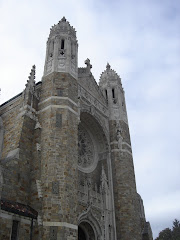







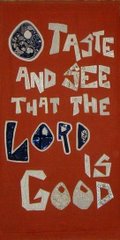
.png)
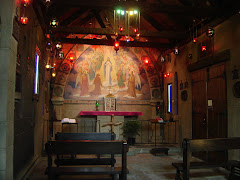






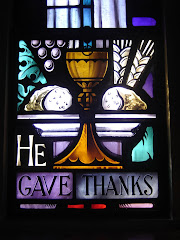
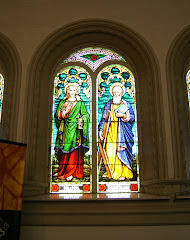
3 comments:
A decade or more earlier our brothers in Abraham commissioned Frank Lloyd Wright to erect a Synagogue in the Elkins Park neighborhood of Philadelphia, similarly Ur-inspired perhaps?
http://www.exploringart.net/index.php?n=FrankLloydWright.BethSholomSynagogue1
Shalom
(derived from shâlêm which means "be complete" or "sound", and can be translated as "peace" or "absence from strife" - as Gideon refers to his majestic Lord, sender of an angel who in ancient times put his mind to rest on the quest.
The Hebrews honored the place so-named with a totemic altar of natural hewn stone, and this sanctuary in Toledo kinda has that "freestyle" one could imagine experienced in the urge to demarcate such a rare and significant encounter with the ephemeral. In accounts recorded by the authors of sacred scripture a notable tree is associated with the place, a terebrinth, with amazing powers of regeneration:
http://israel1234.wordpress.com/2006/12/20/pistacia-atlantica-terebinth/
Indeed the cantankerous Jotham, Gideon's joungest, climbs a mountain opposite the site to berate his fellow Israelites on their use of free will in electing to put a ne'er-do-well in charge of taking care of the people's business.
http://www.nccbuscc.org/nab/bible/judges/judges9.htm#v7
Does this fable of the trees not echo in the buckthorn used to crown Our Lord at the outset of his Via Dolorosa, evil personified as a prickly bramble vanquished by the real Tree of Life. Are we not blessed to be succoured, not with turpentine as God let Jerubbaal contend with (forgive the etymological pun) but the fruit of the vine and the healing oil of the olive that we may be fertilized by the Gifts of the Spirit and bear fruit as ripe as any figs that grace the pages of Holy Writ (which if I understand correctly you may or may not be inclined to read at this crepuscular hour (it's past midnight as I write) but I trust you enjoy reading comments posted, I pray they suffice as a "channel of his peace" for your parched heart!
Thanks for the opportunity to share a favorite passage - the saving grace of the rather non-descript modern edifice our parish calls 'home' is the stained glass crown of thorns above the tabernacle behind the altar... old patterns die hard, ecclesial architechture is a kinda peculiar radar-like sonar-echo-finder down the aeons and ages, for the lumbering idiots we call 'humans', who unlike our sea-born mammal cousins cannot perceive the exquisite infinite unless we're hit on the head with a 2" x 4" ... repeatedly!) N.B. Closing parenthesis may or may not be properly punctuated, I have the rather nasty habit of nesting my thoughts one inside the other... hope they're still intelligible even if they illegible!
God Bless,
Clare
Pique your interest?
... read all about 'ye olde Abiezrites'
(= children of the 'Father-of-Help') at
Gutenberg's repository of out-of-copyright texts in the public domain:
http://www.gutenberg.org/files/17326/17326-h/v6c.htm
with (sorry to put you in the vicinity of a near occasion of sin, but there's all sorts of neat pictures - etchings from old photography and such Enjoy!)
Oooh what a co-incidence, today's the feast of the Exaltation of the Cross.
Here's an image of a close-up of the San Clemente relic of the true cross
www.wf-f.org/ExaltCross.html
ensconced behind the tesserae of the apse mosaic (as noted in the inscription along with bones of the Apostle James and St Ignatius of Antioch) positively billowing with brambly tree of life Celtic curls (a motif of oriental origin, not Hibernian, I understand)
www.wf-f.org/ExaltCross.html
Post a Comment